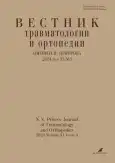Decision-making in unicompartmental knee arthroplasty using radiological parameters in South Asian populations
- Authors: Vijay A.1, Pandian H.1, Elangovan P.1, Vijayakumari A.K.1, Anantharaman G.1, Tajudeen S.M.1, Raghul R.1
-
Affiliations:
- Chettinad Hospital and Research Institute
- Issue: Vol 31, No 3 (2024)
- Pages: 305-314
- Section: Original study articles
- URL: https://bakhtiniada.ru/0869-8678/article/view/290875
- DOI: https://doi.org/10.17816/vto629134
- ID: 290875
Cite item
Full Text
Abstract
Background: Many patients who visit orthopedic surgeons mainly complained of knee pain, which is often diagnosed as osteoarthritis affecting the medial compartment, whereas the lateral compartment and patello-femoral joint remain relatively unaffected.
AIM: This study aimed to establish criteria for patient selection and validate an evidence-based approach for selecting candidates for unicompartmental knee arthroplasty (UKA). Key considerations in patient selection for UKA include identifying the presence of bone-on-bone osteoarthritis in the medial compartment, ensuring a functionally normal anterior cruciate ligament, maintaining full-thickness cartilage in the lateral compartment, verifying a functionally normal medial collateral ligament, and confirming the absence of severe damage lateral to the patello-femoral joint.
MATERIALS AND METHODS: From a consecutive cohort of 390 patients with medial knee pain, preoperative radiographs of bilateral knee including anteroposterior/lateral/Rosenberg/20° valgus stress views were collected, and results were tabulated. Patients were categorized into appropriate groups. The suitability for UKA was determined based on the Oxford radiological decision aid, history, examination, and radiographic assessment including stress radiographs.
RESULTS: The Oxford radiological decision aid demonstrated 92% sensitivity and 88% specificity. According to the radiographic assessment, 49% of the knees were considered suitable for Oxford UKA (OUKA), whereas 51% were deemed unsuitable. Among the 51 knees identified as unsuitable for OUKA, 40% did not meet one radiographic criterion, 38% did not meet two criteria, 22% did not meet three criteria, and <1% did not meet four criteria.
CONCLUSION: The Oxford radiographic decision aid safely and reliably identifies the appropriate patients for meniscal-bearing UKA and achieves good results in this population. The widespread use of this radiological decision aid should improve the results of UKA.
Full Text
##article.viewOnOriginalSite##About the authors
Aswin Vijay
Chettinad Hospital and Research Institute
Author for correspondence.
Email: aswin7009@gmail.com
ORCID iD: 0009-0008-2075-2046
postgraduate student, Department of Orthopaedics
India, Chennai, Chettinad Health City, SH 49A, Kelambakkam, Tamil Nadu 603103Haemanath Pandian
Chettinad Hospital and Research Institute
Email: haemanath@gmail.com
ORCID iD: 0000-0002-6268-9478
associate professor
India, Chennai, Chettinad Health City, SH 49A, Kelambakkam, Tamil Nadu 603103Pradeep Elangovan
Chettinad Hospital and Research Institute
Email: prad_87@yahoo.co.in
ORCID iD: 0000-0003-0312-2428
professor, Department of Orthopaedics
India, Chennai, Chettinad Health City, SH 49A, Kelambakkam, Tamil Nadu 603103Arunkumar K. Vijayakumari
Chettinad Hospital and Research Institute
Email: arun5684@gmail.com
ORCID iD: 0000-0001-8590-0988
associate professor, Orthopaedics
India, Chennai, Chettinad Health City, SH 49A, Kelambakkam, Tamil Nadu 603103Ganesh Anantharaman
Chettinad Hospital and Research Institute
Email: aganesh.anantharaman@gmail.com
ORCID iD: 0000-0002-0692-6213
associate professor, Orthopaedics
India, Chennai, Chettinad Health City, SH 49A, Kelambakkam, Tamil Nadu 603103Sheik M. Tajudeen
Chettinad Hospital and Research Institute
Email: sheik.145@gmail.com
ORCID iD: 0009-0008-9491-0983
senior resident, Orthopaedics
India, Chennai, Chettinad Health City, SH 49A, Kelambakkam, Tamil Nadu 603103Rajan Raghul
Chettinad Hospital and Research Institute
Email: rahul_2022@ymail.com
ORCID iD: 0009-0008-5430-6175
Orthopaedics
India, Chennai, Chettinad Health City, SH 49A, Kelambakkam, Tamil Nadu 603103References
- Hsu H, Siwiec RM. Knee Osteoarthritis. In: StatPearls [Internet]. Treasure Island (FL): StatPearls Publishing; 2023. Available from: https://www.ncbi.nlm.nih.gov/books/NBK507884/
- Lundgren Nilsson Å, Dencker A, Palstam A, et al. Patient-reported outcome measures in osteoarthritis: a systematic search and review of their use and psychometric properties. RMD Open. 2018;4(2):e000715. doi: 10.1136/rmdopen-2018-000715
- McCormack DJ, Puttock D, Godsiff SP. Medial compartment osteoarthritis of the knee: a review of surgical options. EFORT Open Rev. 2021;6(2):113–117. doi: 10.1302/2058-5241.6.200102
- Ode Q, Gaillard R, Batailler C, et al. Fewer complications after UKA than TKA in patients over 85 years of age: A case-control study. Orthop Traumatol Surg Res. 2018;104(7):955–959. doi: 10.1016/j.otsr.2018.02.015
- Shlomo YB, Blom A, Boulton C, et al. The National Joint Registry 16th Annual Report 2019 [Internet]. The National Joint Registry. 2019. Available from: https://www.semanticscholar.org/paper/The-National-Joint-Registry-16th-Annual-Report-2019-Ben-Shlomo-Blom/e73d48948fb87c3830e881c6f2061dd60b531179
- Clement ND, Afzal I, Liu P, et al. The Oxford Knee Score is a reliable predictor of patients in a health state worse than death and awaiting total knee arthroplasty. Arthroplasty. 2022;4(1):33. doi: 10.1186/s42836-022-00132-9
- Oosthuizen C, Burger S, Vermaak D, et al. The X-Ray Knee instability and Degenerative Score (X-KIDS) to determine the preference for a partial or a total knee arthroplasty (PKA/TKA). SA Orthopaedic Journal. 2015;14(3):61–69. doi: 10.17159/2309-8309/2015/v14n3a7
Supplementary files













